
Huntsville is the most populous city in the U.S. state of Alabama. It is the county seat of Madison County with portions extending into Limestone County and Morgan County. It is located in the Appalachian region of northern Alabama south of the state of Tennessee.
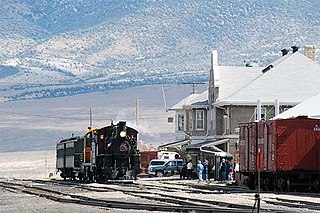
The Nevada Northern Railway Museum is a railroad museum and heritage railroad located in Ely, Nevada, owned by the State of Nevada and operated by a historic foundation dedicated to the preservation of the Nevada Northern Railway.
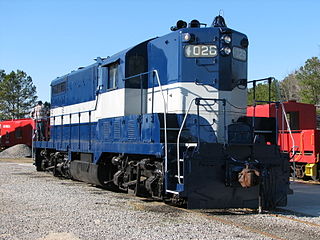
The Georgia Railroad and Banking Company also seen as "GARR", was a historic railroad and banking company that operated in the U.S. state of Georgia. In 1967 it reported 833 million revenue-ton-miles of freight and 3 million passenger-miles; at the end of the year it operated 331 miles (533 km) of road and 510 miles (820 km) of track.

The Central of Georgia Railway started as the Central Rail Road and Canal Company in 1833. As a way to better attract investment capital, the railroad changed its name to Central Rail Road and Banking Company of Georgia. This railroad was constructed to join the Macon and Western Railroad at Macon, Georgia, in the United States, and run to Savannah. This created a rail link from Chattanooga, on the Tennessee River, to seaports on the Atlantic Ocean. It took from 1837 to 1843 to build the railroad from Savannah to the eastern bank of the Ocmulgee River at Macon; a bridge into the city was not built until 1851.

The Memphis and Charleston Railroad, completed in 1857, was the first railroad in the United States to link the Atlantic Ocean with the Mississippi River. Chartered in 1846, the 311 miles (501 km) 5 ft gauge railroad ran from Memphis, Tennessee to Stevenson, Alabama through the towns of Corinth, Mississippi and Huntsville, Alabama. The portion between Memphis and LaGrange, Tennessee was originally to be part of the LaGrange and Memphis Railroad, chartered in 1838. From Stevenson, the road was connected to Chattanooga, Tennessee via the Nashville and Chattanooga Railroad. In Alabama, the railroad followed the route of the Tuscumbia, Courtland and Decatur Railroad between Tuscumbia and Decatur, the first railroad to be built west of the Appalachian Mountains.

Tallahassee station, also known as the Jacksonville, Pensacola and Mobile Railroad Company Freight Depot, is a historic train station in Tallahassee, Florida. It was built in 1858 and was served by various railways until 2005, when Amtrak suspended service due to Hurricane Katrina. It was added to the National Register of Historic Places in 1997.

The William Aiken House and Associated Railroad Structures make up a National Historic Landmark District in Charleston, South Carolina, that contains structures of South Carolina Canal and Railroad Company and the home of the company's founder, William Aiken. These structures make up one of the largest collection of surviving pre-Civil War railroad depot facilities in the United States. The district was declared a National Historic Landmark in 1963.

The Georgia State Railroad Museum is a museum in Savannah, Georgia located at a historic Central of Georgia Railway site. It includes parts of the Central of Georgia Railway: Savannah Shops and Terminal Facilities National Historic Landmark District. The complex is considered the most complete antebellum railroad complex in the United States. The museum, located at 655 Louisville Road, is part of a historic district included in the National Register of Historic Places.

The Historic Railpark and Train Museum, formerly the Louisville and Nashville Railroad Station in Bowling Green, Kentucky, is located in the historic railroad station. The building was placed on the National Register of Historic Places on December 18, 1979. Opened in 1925, the standing depot is the third Louisville & Nashville Railroad depot that served Bowling Green.
Southern Railway Depot, or variations such as Southern Railway Passenger Station or Passenger Depot, Southern Railway Freight Depot or Freight Office, may refer to any of numerous railway stations operated by the U.S.-based Southern Railway or stations operated by other Southern Railway companies.

The Santa Fe Passenger and Freight Depot is a former Santa Fe Railroad station located at 150 Central Valley Highway in Shafter, in the southern San Joaquin Valley within Kern County, California.

The Western and Atlantic Depot is a historic Western and Atlantic Railroad train depot in Dalton, Georgia. It was built in 1852 in the Greek Revival style. The building is the oldest surviving commercial structure in Dalton and is a "fine example" of depot architecture in Georgia in the mid-1800s. It served as both a freight and passenger station.

The Gurley Historic District is a historic district in Gurley, Alabama. The district was listed on the Alabama Register of Landmarks and Heritage in 1995 and the National Register of Historic Places in 2004.

The Madison Station Historic District is a historic district in Madison, Alabama. Madison was first settled around 1818 as a farming community, but significant growth began in 1858, when the first depot was built along the Memphis and Charleston Railroad line. Madison Station became an important loading point for the shipment of cotton, supplanting the Tennessee River as the preferred means of shipment. Merchants and other businesses soon followed, with many people moving from the river port of Triana. After a lull during the Civil War, the town's growth continued; Madison was incorporated in 1869. The town grew steadily until the 1950s, when industry spurred by the expansion of Redstone Arsenal replaced cotton as the primary economic force in Madison County.

The Scottsboro Memphis and Charleston Depot is a historic train station in Scottsboro, Alabama, USA. Built in 1861 on the eve of the American Civil War, the depot is one of three remaining antebellum depots in Alabama built by the Memphis and Charleston Railroad, and the only one outside Huntsville. On January 8, 1865, it was the site of a skirmish between members of the 101st and 110th U.S. Colored Infantry Regiment and Confederate forces which resulted in the retreating rebels setting fire it.

The Stevenson Historic District is a historic district in Stevenson, Alabama. The town was founded in the 1850s at the junction of the Nashville and Chattanooga Railroad and the Memphis and Charleston Railroad. Named for Vernon King Stevenson, the first president of the Nashville & Chattanooga, the town played a vital role in the Civil War as a Union Army headquarters for operations around Chattanooga, Tennessee. Despite postwar efforts to introduce other industrial development to the town, Stevenson's growth stayed tied to the railroad. The district contains several houses and commercial buildings, as well as railroad- and military-related structures constructed between the 1850s and the early 20th century. The Greek Revival Cowan-Rudder House on Main Street served as the headquarters of Union General Włodzimierz Krzyżanowski from 1863 until 1865. Many frame commercial buildings were destroyed in a 1911 fire and replaced with brick and masonry structures; one notable building to survive the fire is the Italianate City Hall, built circa 1875 to house the town bank. The Stevenson Railroad Depot and Hotel was built in 1872 as a joint project of the Memphis & Charleston and Nashville & Chattanooga railroads. The district was listed on the National Register of Historic Places in 1978.
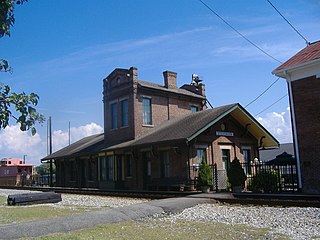
The Stevenson Railroad Depot and Hotel station are a historic train station and hotel in Stevenson, Alabama. They were built circa 1872 as a joint project of the Memphis and Charleston Railroad and the Nashville and Chattanooga Railroad, whose lines converged in Stevenson. When the Memphis & Charleston was purchased by the Southern Railway in 1898, the Louisville and Nashville Railroad took sole control of the depot and operated it until 1976. It was converted into a history museum in 1982. Both buildings are brick with gable roofs and Italianate details. The depot has a central, second-story tower that was added in 1887. The three-story hotel had a lobby, dining room, and kitchen on the first floor and eight large guest rooms on the upper floors. The buildings were listed on the Alabama Register of Landmarks and Heritage in 1975 and the National Register of Historic Places in 1976.
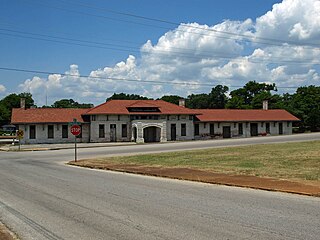
The Southern Railway Depot is a historic building in Decatur, Alabama. The depot was built in 1904–05 along the Southern Railway line. Decatur had become a transportation hub of North Alabama by the 1870s, with its connections to the Tennessee River, the east–west Tuscumbia, Courtland and Decatur Railroad, and the north–south Louisville and Nashville Railroad.
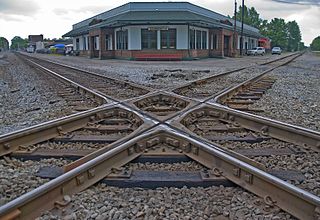
The Corinth Depot, also known as the Gulf, Mobile and Ohio Depot, is located at 221 North Fillmore Street in Corinth, Mississippi. Built circa 1917, the depot is the home of the Crossroads Museum. It is a contributing property to the Downtown Corinth Historic District, which was placed on the National Register of Historic Places in 1993. In 1995, the depot was designated a Mississippi Landmark.























